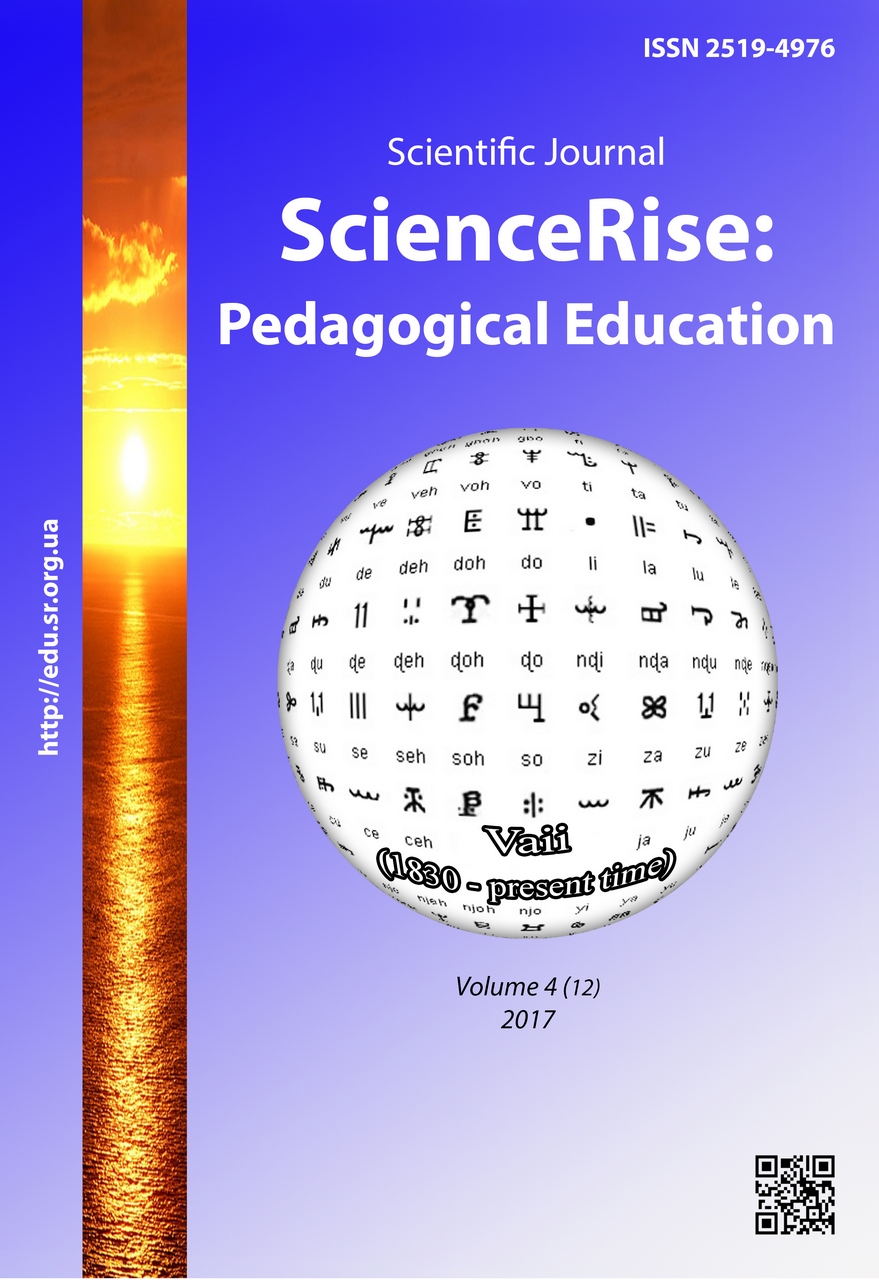Development of folk libraries-reading rooms in Kyiv region (end of XІХ – early ХХ century)
DOI:
https://doi.org/10.15587/2519-4984.2017.100340Keywords:
folk libraries-reading rooms, simplified libraries, district libraries, educational organizationsAbstract
The article presents the phenomenological analysis of the notion “folk libraries-reading rooms” defined in historical-pedagogical literature as an important instrument of out-school education of population. The conclusion was made that just educational and public organizations were initiators and organizers of establishment and development of folk libraries-reading rooms. The experience of activity of the committee of care about people soberness, committee of literacy of district organizations in the work of folk libraries-reading rooms at the end of ХІХ – early ХХ century is characterized in the work. There was analyzed the activity of first reading rooms at teahouses in Kyiv region. As an example, there were presented the data about opening of the “Folk teahouse” at Lukyanivka. The archive material about the activity of Pavlenko folk simplified libraries was introduced into scientific circulation. The cultural-educational role of folk libraries-reading rooms in cultural life of pre-revolutionary Kyiv region was determined. The features of establishment and functioning of aforesaid libraries were revealed on the base of the analysis of archive sources.
The article presents the analysis of the notion “folk libraries-reading rooms”. They are defined in historical-pedagogical literature as an important instrument of out-school education of population. The conclusion was made that just educational and public organizations were initiators and organizers of establishment and development of folk libraries-reading rooms. The experience of activity of the committee of care about people soberness, committee of literacy of district organizations in the work of folk libraries-reading rooms at the end of ХІХ – early ХХ century is characterized in the work. There was analyzed the activity of first reading rooms at teahouses in Kyiv region. As an example, there were presented the data about opening of the “Folk teahouse” at Lukyanivka. The archive material about the activity of Pavlenko folk simplified libraries was introduced into scientific circulation. The cultural-educational role of folk libraries-reading rooms in cultural life of pre-revolutionary Kyiv region was determined. The features of establishment and functioning of aforesaid libraries were revealed on the base of the analysis of archive sources
References
- Ajvazyan, O. B. (2014). Narodni biblioteky Podilskoyi guberniyi naprykinci XIX – na pochatku XX stolittya. Naukovi zapysky Vinnyczkogo derzhavnogo pedagogichnogo universytetu imeni Myxajla Kocyubynskogo. Seriya: Istoriya, 22, 129–134. Available at: http://lib.khnu.km.ua/about_library/naukova_robota/2014/aiv_nar.htm
- Ajvazyan, O. B. (2010). Biblioteky osvityanskyx zakladiv Podilskogo yeparxialnogo vidomstva drugoyi polovyny XIX – pochatku XX stolittya. Naukovi pratsi Kam"yanets'-Podil's'koho natsional'noho universytetu imeni Ivana Ohiyenka. Seriya: Bibliotekoznavstvo. Knyhoznavstvo, 2, 123–136. Available at: http://nbuv.gov.ua/UJRN/npkpnuiobk_2010_2_15
- Milyasevych, I. (2007). Biblioteky Volynskogo Opikunstva pro narodnu tverezist (kinecz XIX – pochatok XX st.). Bibliotechna planeta, 4, 21–24.
- Shandra, B. C. Narodni biblioteky. Encyklopediya istoriyi Ukrayiny. Kyiv, 7, 194.
- Solomonova, T. R. Narodni biblioteky ta chytalni komitetiv pikluvannya pro narodnu tverezist (na prykladi Vinnyczkogo povitu Podilskoyi guberniyi). Naukovi pratsi Kam"yanets'-Podil's'koho natsional'noho universytetu imeni Ivana Ohiyenka. Seriya: Bibliotekoznavstvo. Knyhoznavstvo, 2, 180–190.
- Luchka, L. M. (2015). Pershi biblioteky Katerynoslava. Prydniprov'ya: istoryko-krayeznavchi doslidzhennya, 13, 146–153.
- Chubar'yana, O. S. (Ed.) (1976). Slovar byblyotechnix termynov. Moscow: Knyga, 224.
- Prugavin, A. S. (1895). Zaprosy naroda i obyazannosti intelligencii v oblasti prosveshcheniya i vospitaniya. Saint Petersburg: Tipografiya I. N. Skorohodova, 547.
- Znyshhenko, N. P. (1997). Biblioteky yak oseredky kulturno-prosvitnyczkoyi roboty u diyalnosti «Kyyivskogo tovarystva Gramotnosti» (1882–1908). Visnyk Knyzhkovoyi palaty, 11, 31–35.
- Kappeler, A. (2005). Rosiya yak polietnichna imperiya: Vynyknennya. Istoriya. Rozpad. Lviv: Vydavnytstvo UKU, 372.
- Otchet o deyatelnosty Kyevskogo Obshhestva Gramotnosty za 1906 god (1907). Kyiv: Tipografiya 1-j Kievskoj Arteli pechatnogo dela, 99.
- Otchet o sostoyanii i deyatel'nosti Kievskoj (2-j) gor. besplatnoj narodnoj chital'ni im. A. S. Pushkina za (1901–1905) gg. (1906). Kyiv, 46.
- Otchet o deyatel'nosti Kievskoj (3-j) gor. besplatnoj narodnoj biblioteki-chital'ni im. V. A. Zhukovskogo za (1903–1904) gg. (1905). Kyiv, 27.
- Poyasnitel'naya zapiska k planu predpolagaemogo k postrojke v g. Kieve peredvizhnogo pavil'ona dlya prodazhi knig s peredvizhnymi narodnimi chital'nyami kak odno iz sredstv dlya religiozno-nravstvennogo prosveshcheniya prostogo russkogo pravoslavnogo naseleniya Yugo-Zapadnogo kraya (1889). Kyiv, 26.
- DAKO, f. 10, op. 1, spr. 261, ark. 155.
- DAKO, f. 351, op. 1, spr. 48, ark. 4–69.
- DAKO, f. 354, op. 1, spr. 16.
- DAKO, f. 354, op. 1, spr. 16, ark. 100.
- DAKO, f. 354, op. 1, spr. 16, ark. 54.
- DAKO, f. 1239, op. 5, spr. 305, ark. 41.
- Statut narodnoyi biblioteky-chytal'ni Kiyivs'koho tovarystva hramotnosti v m. Kiyevi (1899). Statut, instruktsiyi i polozhennya Kiyivs'koho tovarystva hramotnosti, 11–14.
- DAKO, f. 1239, op. 5, spr. 208.
Downloads
Published
How to Cite
Issue
Section
License
Copyright (c) 2017 Natalia Sharoshkina

This work is licensed under a Creative Commons Attribution 4.0 International License.
Our journal abides by the Creative Commons CC BY copyright rights and permissions for open access journals.
Authors, who are published in this journal, agree to the following conditions:
1. The authors reserve the right to authorship of the work and pass the first publication right of this work to the journal under the terms of a Creative Commons CC BY, which allows others to freely distribute the published research with the obligatory reference to the authors of the original work and the first publication of the work in this journal.
2. The authors have the right to conclude separate supplement agreements that relate to non-exclusive work distribution in the form in which it has been published by the journal (for example, to upload the work to the online storage of the journal or publish it as part of a monograph), provided that the reference to the first publication of the work in this journal is included.








